This guide to the best things to do in Yangon Myanmar showcases the main attractions such as Shwedagon Pagoda, Sule Pagoda, Kandawgyi Lake, and more.
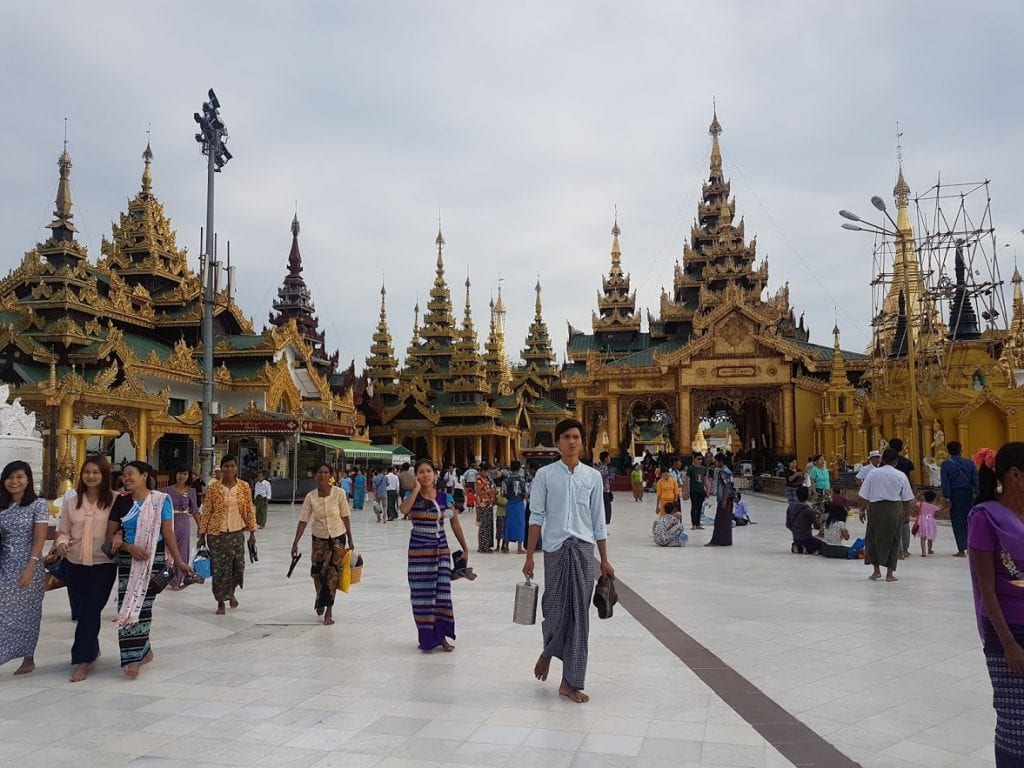
Things To Do In Yangon Myanmar
In January 2019, we spent five days in Yangon, Myanmar’s capital. This was part of a longer five month trip around the Asia region.
Myanmar was a country we hadn't visited before, and so this was also our first time in Yangon. Our first impressions, were that the city seemed to have come out of another era, with its numerous pagodas and hundreds of colonial buildings.
We created this guide on things to do in Yangon Myanmar based on our own experiences there. It also includes other essential information such as the best time to visit Yangon, where to stay in Yangon and more.

Where Is Yangon Myanmar
Yangon is the capital of Myanmar, the country west of Thailand which was formerly known as Burma. It is located close to the Gulf of Martaban, which opens to the Andaman Sea, and eventually to the Indian Ocean, therefore occupying a very strategic spot on the map.
Why Should I Go To Yangon Myanmar
Yangon started off as a small fishing village around the 11th century, and only started growing in the mid-18th century, when it became a major port under King Alaungpaya.
The city was occupied by the British in 1852, and soon became the largest financial and commercial centre of the country, called Rangoon. New infrastructure was raised in the form of mansions, hospitals and schools, and a few parks were laid out.
The Burmese Independence Movement, aiming to free the country from the British, started off in Yangon, and the country won its independence after World War II, in 1948.
Today, Yangon is a busy, sprawling city of over 5 million people. Compared to other cities in SE Asia, the centre of the colonial Rangoon isn’t as modernized and developed.
There are big traditional markets, and the hundreds of colonial buildings are still there, many of them in decay. Malls don’t seem to be a focus of the city, like for example in Bangkok, and can be mostly found in the suburbs.
People often go to Yangon on the popular Yangon – Bagan – Inle Lake itinerary. If you are travelling to Bagan, Yangon is an easy point of entrance to the country. At the same time, it has lots of sightseeing to offer.
Yangon Myanmar Things To Do
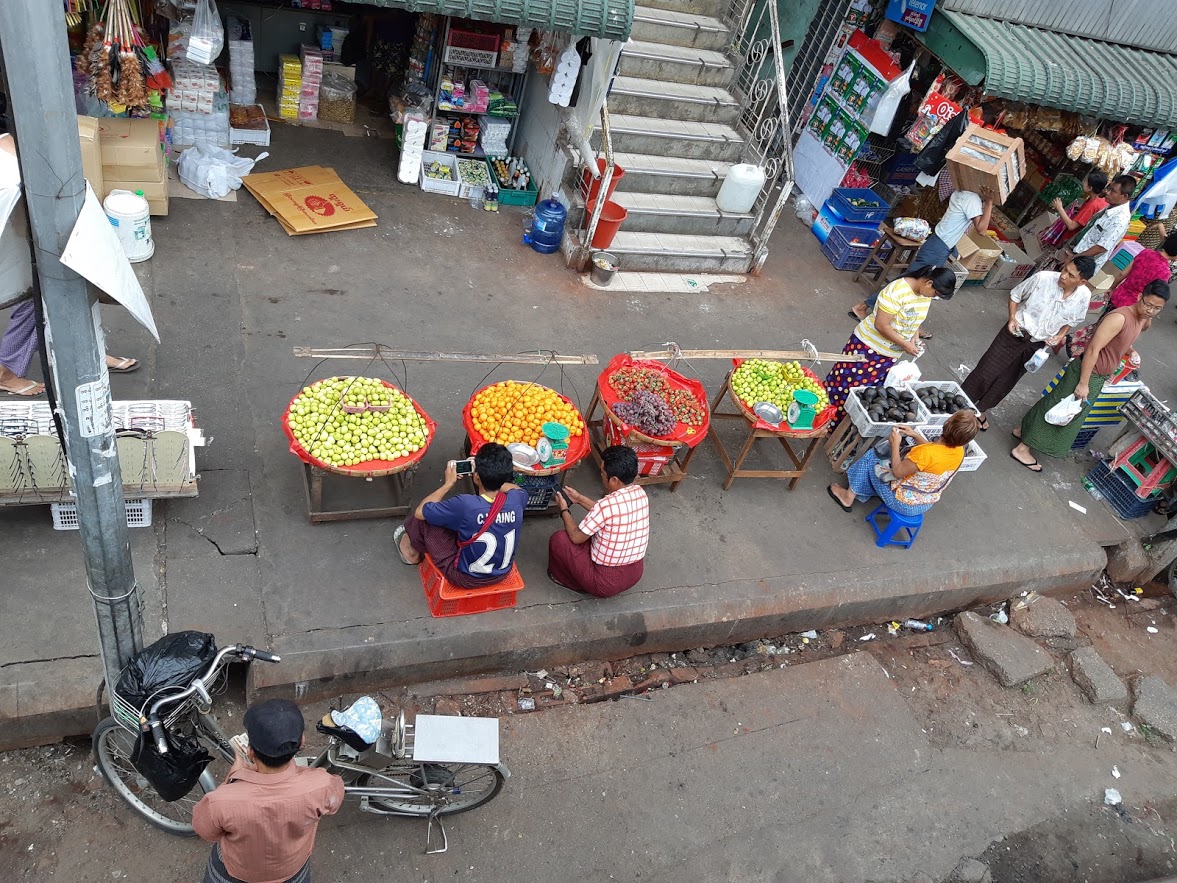
In downtown Yangon, the colonial buildings are laid out in several well-structured blocks. The streets resemble NYC somehow, as they are numbered from 1 (west downtown), to about 70 (east downtown).
As a result, it’s very easy to get around downtown Yangon without a map. If in doubt, look around for the downtown’s landmark, the majestic Sule Pagoda.
Apart from all sorts of temples and pagodas, downtown Yangon has several markets, a Chinatown, and plenty of restaurants, bakeries and food stalls.
If you get out of the centre, you can find more serene environments, such as Kandawgyi Lake and the much bigger Inya Lake.
As for Yangon’s highlight, this has to be the massive Shwedagon pagoda, Myanmar’s greatest temple.
Pagodas and Temples in Yangon Myanmar

Yangon has an abundance of pagodas, while temples of many other religions are also dotted around throughout the city.
You can see Hindu temples, Chinese temples, Catholic temples, even a Synagogue.
Even if you are not religious, you will be fascinated by the multitude of places of worship in Yangon. If you want to visit any of them, remember to dress appropriately, and to remove your shoes before you enter a Buddhist temple.
One more thing – just like in many other places in SE Asia, you will often encounter monks and nuns walking around the city with alms bowls, looking for a donation. Whether you want to donate or not is up to you, but if not, you may just bring your hands together in front of your chest and just nod in respect.
Shwedagon Pagoda in Yangon

Shwedagon Pagoda is one of the most famous Buddhist temples in SE Asia and perhaps the world. It is a large complex containing many stupas and Buddha statues, and it is home to eight of the Buddha’s strands of hair and a few other sacred relics.
The Shwedagon Pagoda was possibly founded between 6th-10th centuries AD, though according to popular legend it’s a lot older. During the centuries, it has suffered earthquakes, pillaging and vandalism, but has also been restored and enlarged several times.
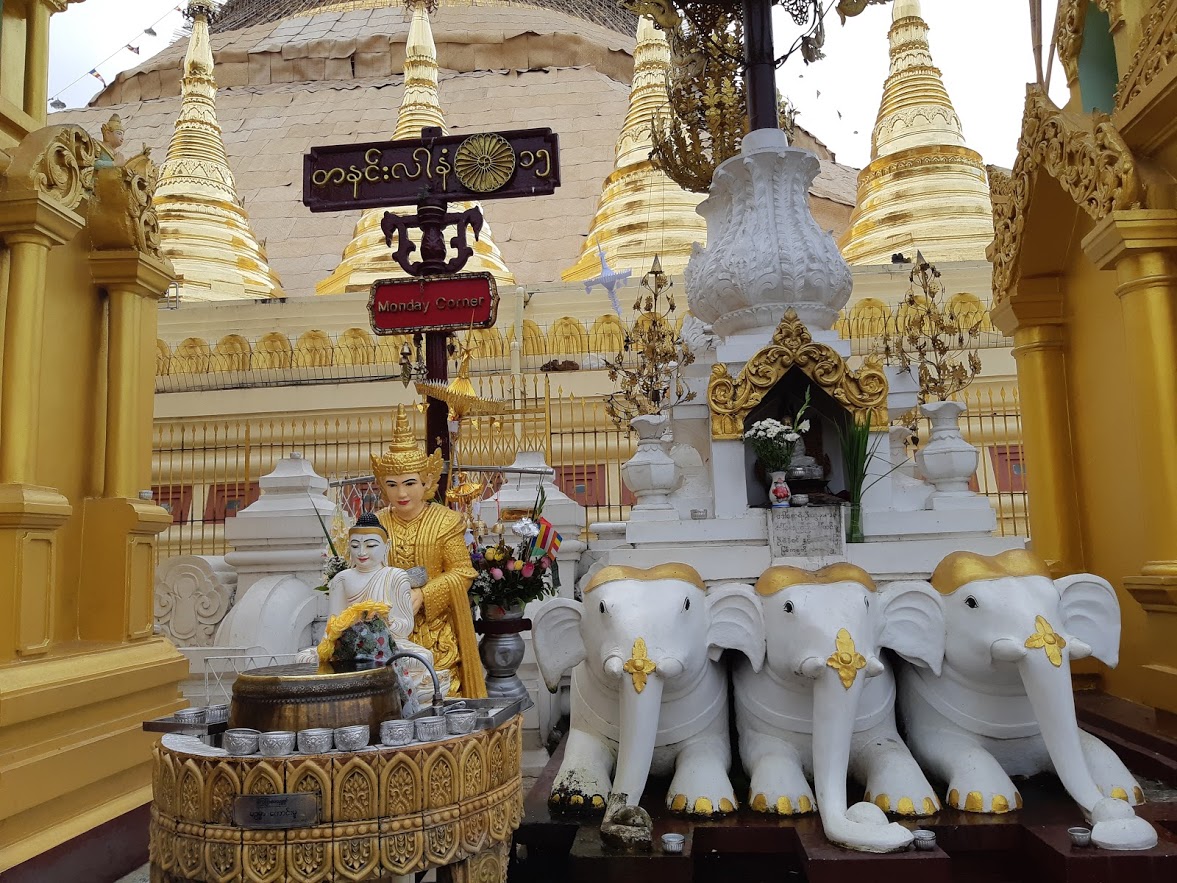
Today, the biggest stupa, which was unfortunately covered in scaffolding when we visited, is 99 m tall and covered with gold leaves that glisten in the sunshine. There are hundreds smaller stupas and statues all around the complex.
The Shwedagon Pagoda is popular among locals who come to pray and perform certain rituals, but also among tourists, so it seems to be busy at all times. Even with the crowds, it is truly a majestic pagoda.
We visited in the late afternoon, and spent a couple of hours. Popular times to visit are at sunrise and at sunset, while staying after dark will give you different views.
The entrance to Shwedagon Pagoda is through four staircases, one on each side of the temple. This was the only temple in SE Asia where we took our shoes with us when we entered, as we weren’t sure if we would find them again.
Sule Pagoda Yangon
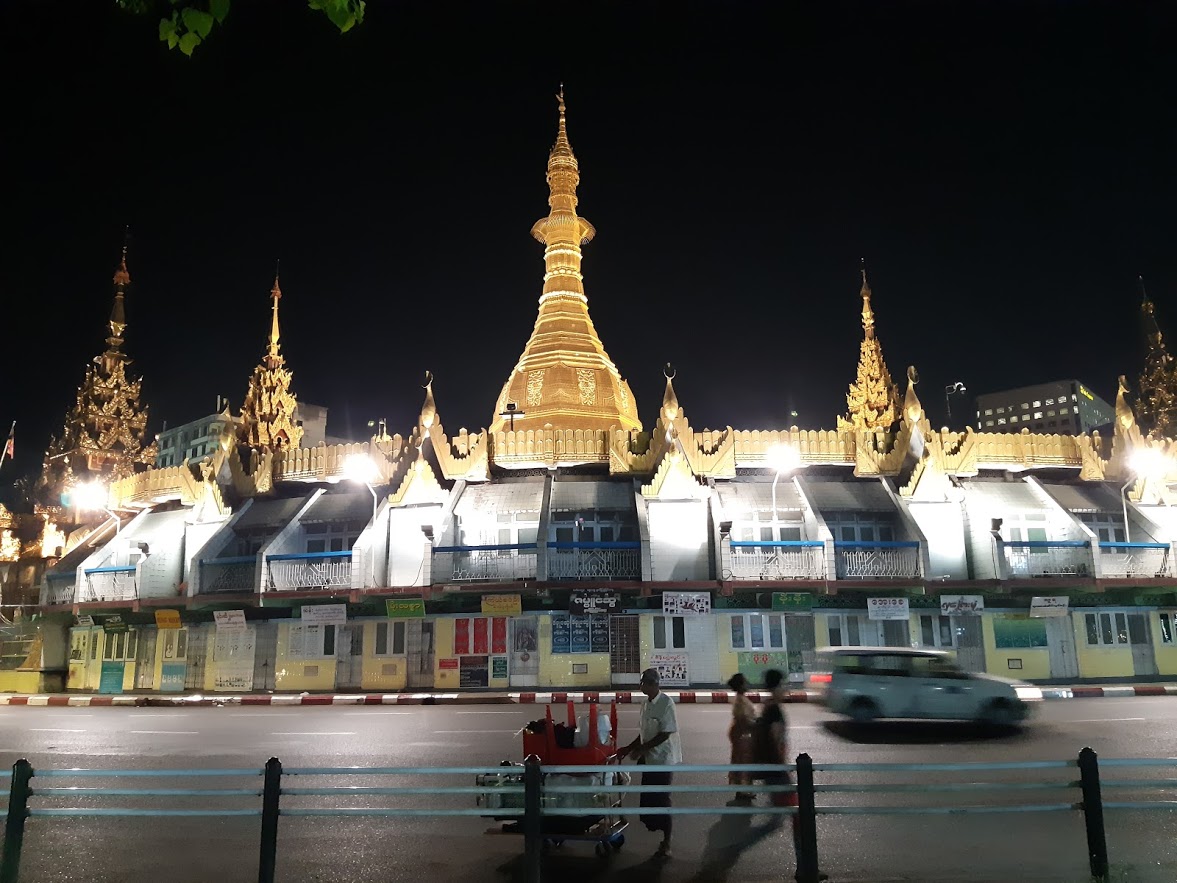
The downtown’s most important landmark, Sule Pagoda, is said to have been built at the time when the Buddha was alive – though it’s more probably contemporary with the Shwedagon Pagoda.
It sits right in the middle of the downtown, and although it’s a little grim and gloomy during the day, it is beautifully lit up at night. All around it, there are small souvenir shops and a few other businesses.
See the Reclining Buddha at the Chauk Htat Gyi Pagoda
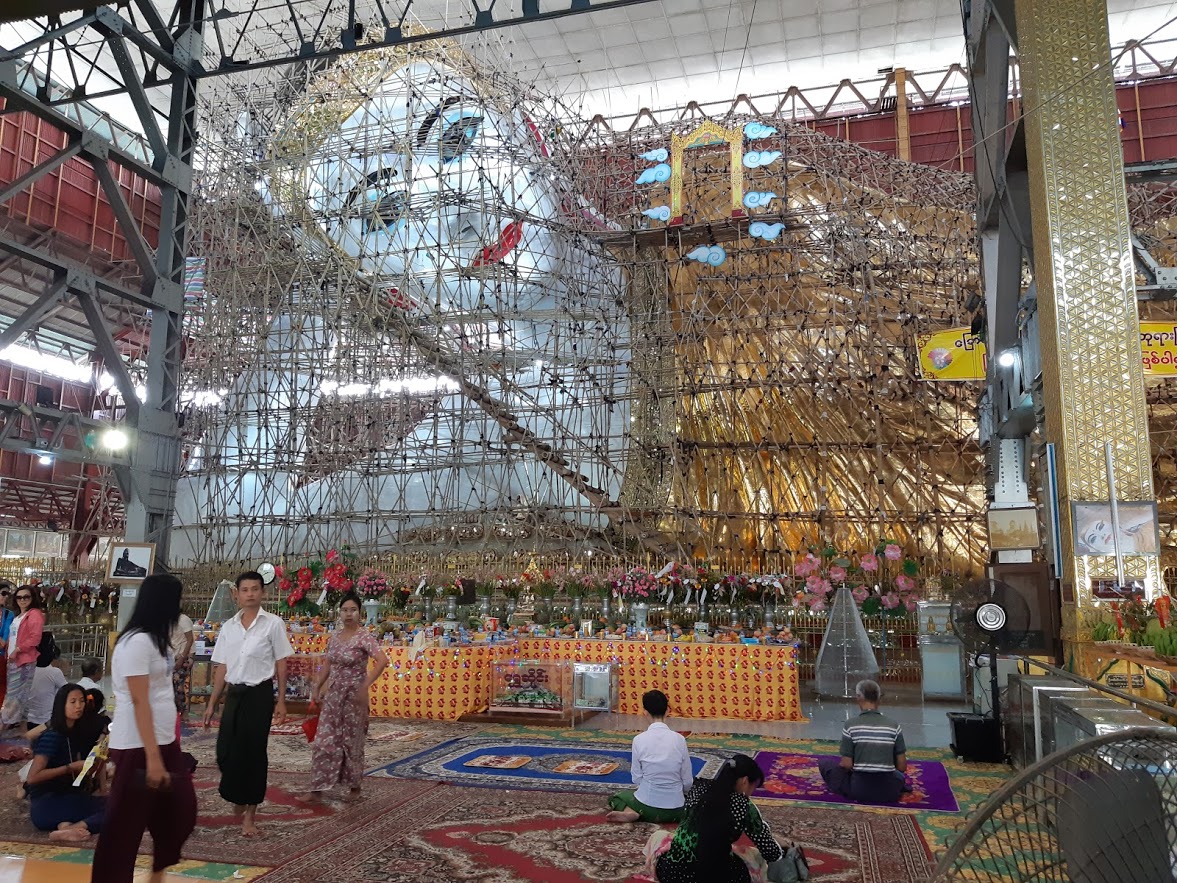
This temple is home to a huge reclining Buddha. At the time we visited it was under restoration, and watching the process was actually very interesting.

This statue reminded us of the Wat Pho temple in Bangkok , but this is a lot bigger – it is 66 metres long and its eyes are about 50 cms, with massive eyelashes.
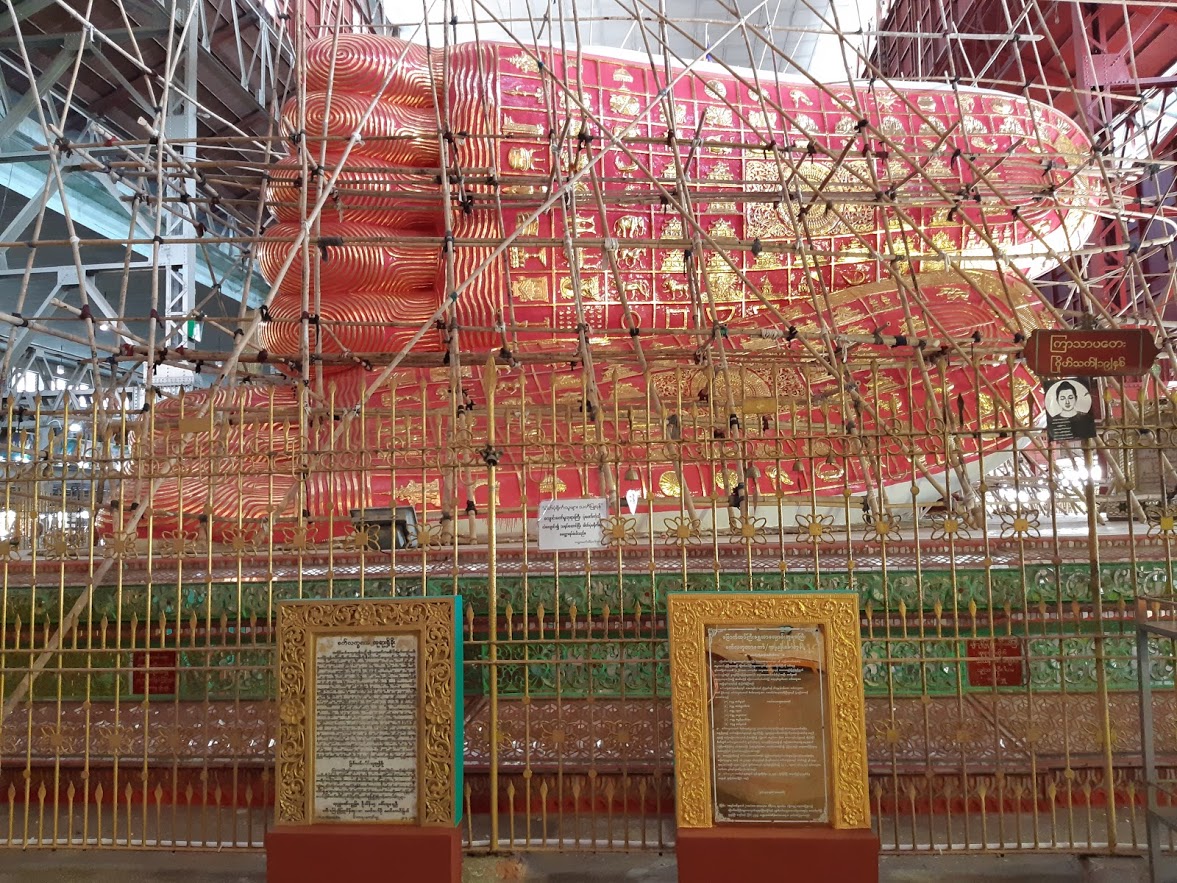
The statue’s huge feet are decorated with several symbols representing the Buddha, such as white elephants, tigers and flowers. The circles at the centre of the feet represent chakras.
See the Seated Buddha in the Nga Htat Gyi Pagoda
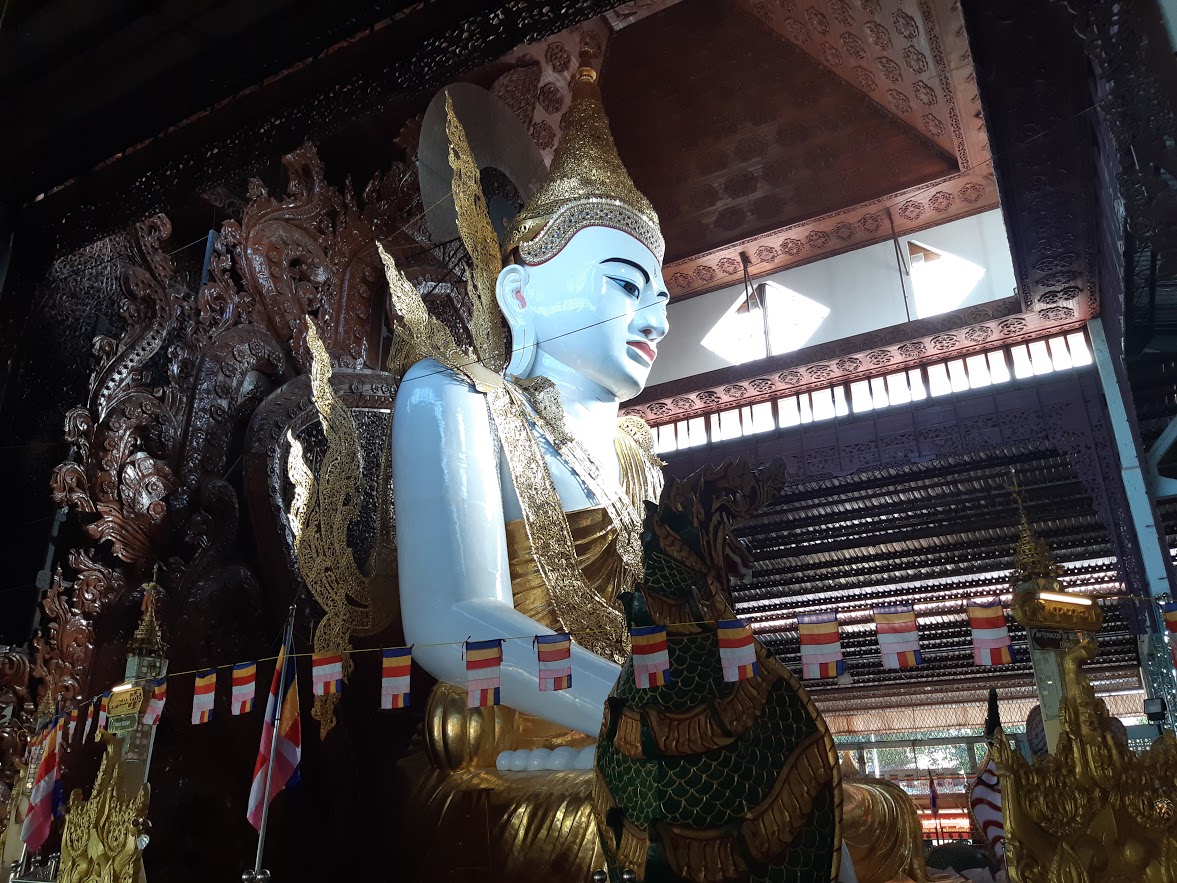
This temple, which is really close to the Chauk Htat Gyi temple, was one of our highlights in Yangon. Here, there is one of the most impressive and beautiful Buddha statues we saw in our whole five-month trip to SE Asia. It has a very peaceful expression and large pink fingernails, and is very imposing and calm.
If you ever wanted to meditate or pray to the Buddha, this is a great place to be. Surprisingly, we didn’t see any tourists here, but there were several locals praying.
Both the Chauk Htat Gyi Pagoda and the Nga Htat Gyi Pagoda are quite close to the Shwedagon Pagoda, so if you are staying in the downtown you can easily combine all of those three in the same day, along with one of the parks.
Stroll around downtown Yangon and appreciate the colonial architecture
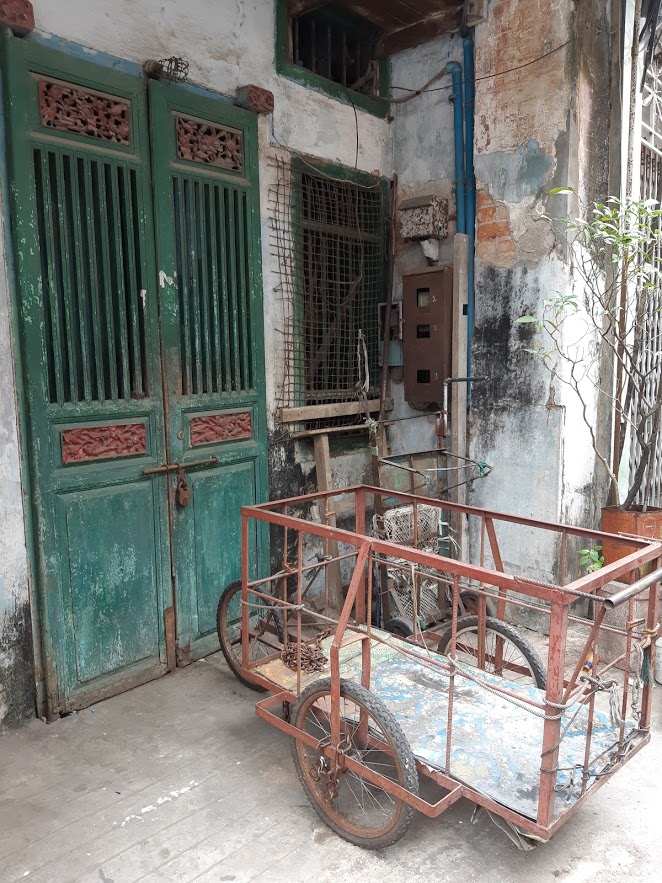
If you are in downtown Yangon, there is one thing you will definitely notice, and that’s the stunning colonial architecture. You will see hundreds of old, decaying buildings everywhere in the city. While some of them have been restored, the majority of them are in bad condition, which only adds to the charm of Yangon, and reminded us of Havana in Cuba.
If you look closely behind the closed windows, the broken shutters and the torn curtains, you will most likely realize that those buildings aren’t empty. The best giveaway is the endless lines of clothes drying around the city.
At night, the streets become alive with street food vendors and various stalls. Take in the smells and sounds of the city after dark, as they will be gone by sunrise. Beware of the holes in the ground, and the occasional rat.
It is possible to take a free Yangon walk which we were planning to do, but due to the heavy rain on that day it wasn’t possible.
Visit Yangon’s China Town and Theingyi Street Market
This is a lovely, lively area full of shops and street food stalls. Located roughly between Shwedagon Pagoda Road and Lanmadaw streets, south of Anawrahta Road, Yangon’s China Town is a fascinating area where you can see the locals going about their daily life. Behind them, you will see crumbling colonial buildings – try to take a peek inside and see how people live.
Just to the east of Chinatown you can also visit the Theingyi Street Market, a chaotic, sprawling area full of stalls, shops, clothes, piles of junk and people, lots of people. This whole area is great if you want to get snacks or cheap clothes, or just look around. It’s an authentic market, and it’s very different from the polished, touristy markets in Chiang Mai.
On the 26th street, there is a big wet market with fruit, veg, meat and fish, so if you are missing some fresh fruit, it’s a good place to head to.
Visit Bogyoke Aung San Market
This orderly, clean market is where you can get clothes, textiles, jewelry, paintings, handicrafts and souvenirs to take back home. There is also a food court but it tends to get very busy and warm.
Although we spotted a few locals buying textiles, we thought that Bogyoke market was quite touristy. Still, it’s probably the best market to go if you are not interested in busy local markets. Note that it’s closed on Mondays!
Spend some time in Kandawgyi Park
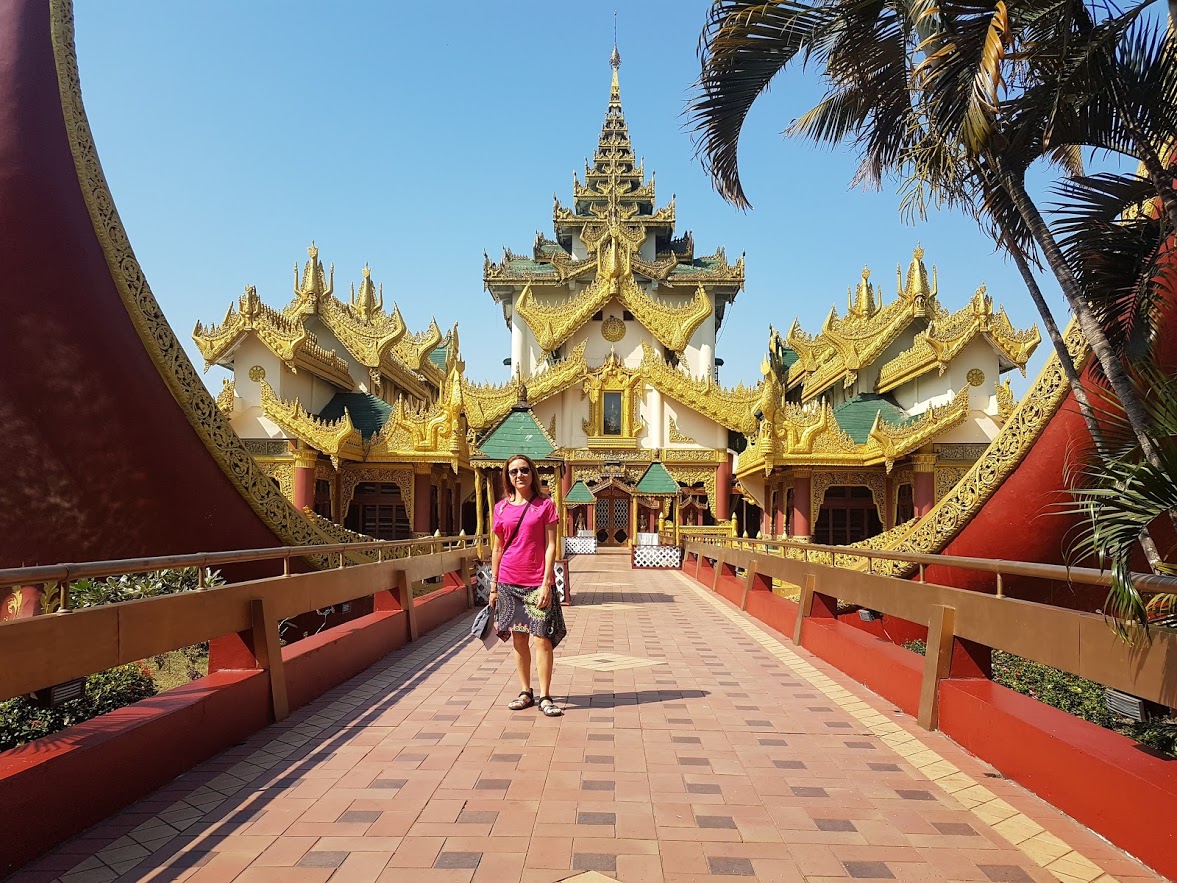
We spent some time strolling around Kandawgyi Park on a very hot day. It was quite nice to leave behind the noisy, crowded centre for a couple of hours. As it was a weekend, there were many locals out and about, and even a festival with local products.
We entered the park on the Karaweik Palace side, but the west side seemed more pleasant, as it was greener. There was a small fee to enter the park, which we thought was only payable by foreigners.
The Shwedagon Pagoda is very close to the park, so you can easily combine them in the same day.
National Museum of Myanmar

We visited the National Museum of Myanmar on our last day in Yangon. It is a large museum sprawling on the basement plus four floors, and photography is not allowed, though we managed to sneak a couple of shots.
The museum proved to be one of our top things to do in Yangon. Although it’s a bit dated, the collections are really cool, and offer a great insight in Myanmar’s history and cultural diversity.
The fourth floor showcases costumes used by the different tribes of Myanmar, which we found really interesting. There are also golden regalia and the massive Lion throne that belonged to King Thibaw Min, the last king of Myanmar.
What we also found fascinating were some of the statues and artwork, and the similarity to some Ancient Greek art.

Take The Local Train Going Around Yangon
We had planned on going around the city in this inexpensive local train, as it seemed to be one of the best things to do in Yangon. We kept postponing it until our last day in Yangon, and then we got super lazy and never went on the ride but went to the museum instead. Something to look forward to if we ever find ourselves there again!
According to our information, trains depart every 30-60 minutes from Yangon Central Railroad station, north of the Sule Pagoda. The ride lasts about 3 hours and there is no toilet on the train, so be prepared!
Day Trips From Yangon
- If you are staying here long enough, there are a few day trips from Yangon worth taking:
The Kyaiktiyo Golden Rock Pagoda, a pagoda impressively perched on top of a rock, all covered in gold. - Bago, a village a couple of hours away from Yangon. It is home to Myanmar’s tallest pagoda, the Shwemawdaw Paya, with a height of 116 meters. In Bago you can see numerous other pagodas and monasteries, while there is also a statue of a reclining Buddha.
- The Taukkyan War Cemetery, where British Commonwealth Allied soldiers who died during World War II are buried.
- Hpa-an, a small picturesque town where you can see local markets and beautiful landscapes and meet friendly Burmese.
Food in Yangon
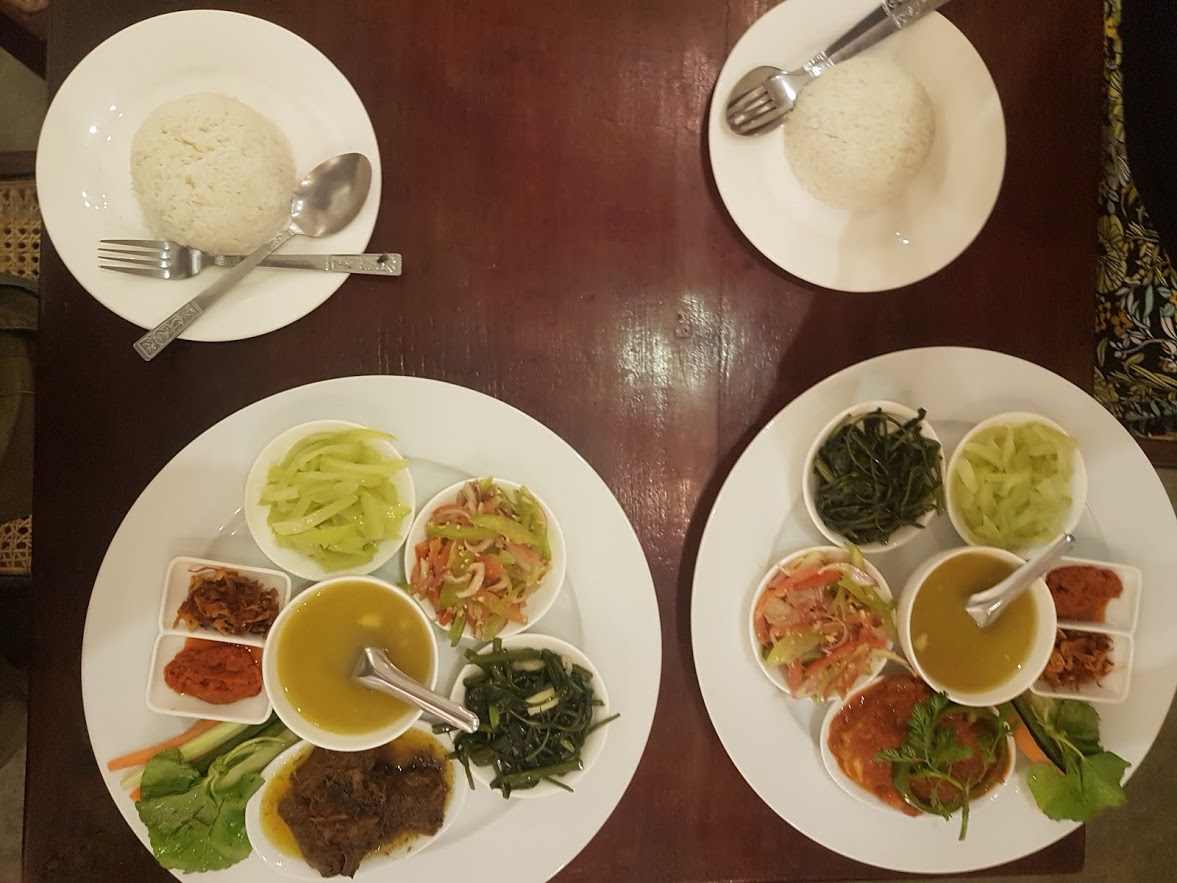
Yangon has an interesting mix of Indian, Chinese and Burmese restaurants, while these days you can find a few westernized restaurants catering to tourists and expats, but also frequented by locals. Throw in the numerous food stalls and colourful food markets, and you will find that there is enough variety to keep you happy for as long as you stay here.
Something that deserves special mention is the tea and teahouses in Yangon. Make sure you have one of the traditional teas, that may contain different amounts of evaporated and / or condensed milk. The tea ritual in Yangon reminded us of the Greek coffee culture!
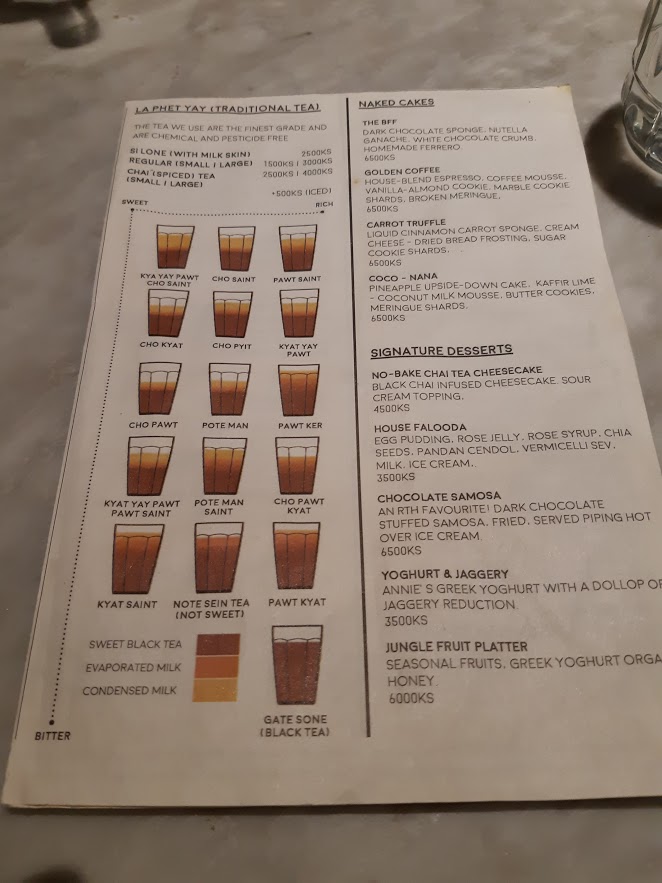
Art scene in Yangon
If you are interested in art, Yangon might surprise you. There were many small galleries and independently ran societies, and there seem to be many artists in the city.
When we were there, we visited an interesting exhibition in the Goethe institute, but also passed by a couple of small galleries that were hosting temporary exhibitions.
Make sure you pick up a leaflet with information on what’s on in Yangon at the time of your visit, and you might be surprised.
Getting around Yangon
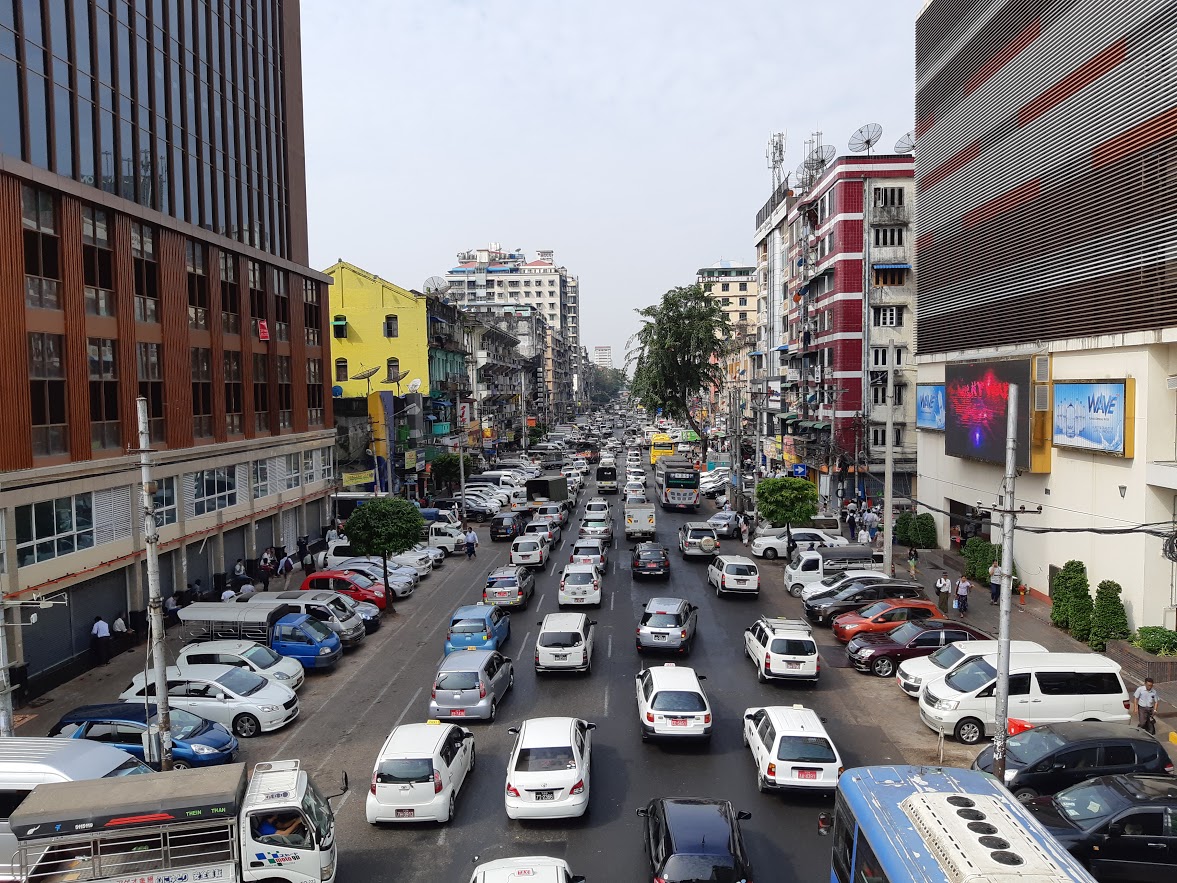
In our experience, there were really two ways to get around Yangon – either on foot, or by Grab taxi. While the downtown is entirely walkable, we didn’t feel like walking to Shwedagon Pagoda or all the other sights we wanted to visit, so we used Grab taxis for those routes.
The average cost of a Grab taxi ride was around 2,000-2,400 MMK (1.1 – 1.4 euro), so it didn’t exactly break the bank.
Added bonus – all Grab taxis were very well maintained and clean in comparison with a couple of normal taxis we hailed from the street!
One thing that may delight you is the fact that motorcycles have been banned in Yangon – and apparently even bicycles are illegal in some areas of the city. Although Yangon was very different to motorbike-infested Hanoi in that respect, it was still quite busy with traffic.
Where to stay in Yangon
Booking.com
Finding decent accommodation in Yangon wasn’t as easy as we had expected. Although there are many hotels in Yangon, some of them were beyond our budget, while others seemed to have pretty bad reviews.
There were plenty of seemingly badly maintained hotels in the downtown, while there were others closer to the Shwedagon Pagoda that looked nicer, but were far off from the centre.
We eventually settled on Hotel K in downtown Yangon, which actually proved to be great. The rooms were clean, towels changed on a daily basis, and our room on the 8th floor was really quiet.
The buffet breakfast was mainly Chinese style, so after five days we were looking forward to having something different to begin the day with, but for those who like Chinese food it was a really good deal, all things considered.
We were happy to stay in bustling downtown Yangon. For people looking a more relaxed environment, the Merchant Art Hotel which is walking distance to Shwedagon Pagoda seemed like a great option.
How To Get To Yangon
You can fly to Yangon directly from nearby countries, and there are also local flights within Myanmar.
You can get to Yangon by bus from several places in Myanmar, including Mandalay (18 hours), Bagan (10 hours) and Inle Lake (10 – 12 hours). Bear in mind that buses might either be fully air-conditioned, or really warm.
Our bus from Nyaung Shwe in Inle Lake took around 12 hours and it was mostly air-conditioned, so we had to keep our jackets and double trousers on at all times.
It is also possible to travel from / to Yangon by train from popular places like Mandalay (15 hours) and Bagan (17 hours). While we didn’t take the train ourselves, we read that it is not an entirely pleasant experience – though if we went back, we might try it for a short ride.
Best Time Of Year To Visit Yangon

In our experience, visiting Yangon in January was pretty good. Even though we had a day of rain, and the temperatures were quite high during the day, it was overall decent weather.
Similar to the rest of Myanmar, Yangon has three seasons:
- The dry season, November to February. This is the best time of year to visit Yangon. Although temperatures can rise to above 30 C during the day, they drop considerably during the night, so evenings will be very pleasant and you might even need a light jacket.
- The hot season, March to May. This time of year in Yangon gets hot and humid, with temperatures reaching an uncomfortable 40 C. Unless you cope very well with the heat, you might prefer to avoid this time of the year to visit Yangon.
- The rainy season, June to September. This is the monsoon season, when storms appear on pretty much a daily basis, especially in July and August. We would probably avoid this time of year to travel to Myanmar, as most of the country would be affected by the strong rain. If this is the only time of year you can go, you will be pleased to know that accommodation is a lot cheaper than in the dry season. Make sure you bring waterproof shoes, as the city’s streets can easily flood.
Festivals In Yangon
A number of festivals take place in Yangon, though if you have a special interest in local festivals you should perhaps look to spend some time in the countryside. If you are going to Yangon during the festival time, make sure you book your accommodation in advance.
March – Shwedagon Pagoda Festival. Pagoda festivals are prominent all around Myanmar, and the Shwedagon Pagoda Festival is one of the biggest. Religious rituals are combined with an all-round festive atmosphere, including dances, singing and arts, as well as a range of stalls selling traditional street food. The festival is celebrated on the full moon night in March.
April – Thingyan Water Festival. Celebrated all around Myanmar, the Thingyan water festival signifies the beginning of the Burmese New Year. People go around the city splashing water at each other, and it’s a particularly fun time for children. The Thingyan Water Festival takes place between 13 – 16 April.
September / October – Thadingyut Festival of lights. During this important festival, which happens all around the country, a number of lit lanterns are let to float into the sky. It’s one of the most picturesque festivals in Myanmar to watch, and anyone can participate, by creating and offering their own lantern.
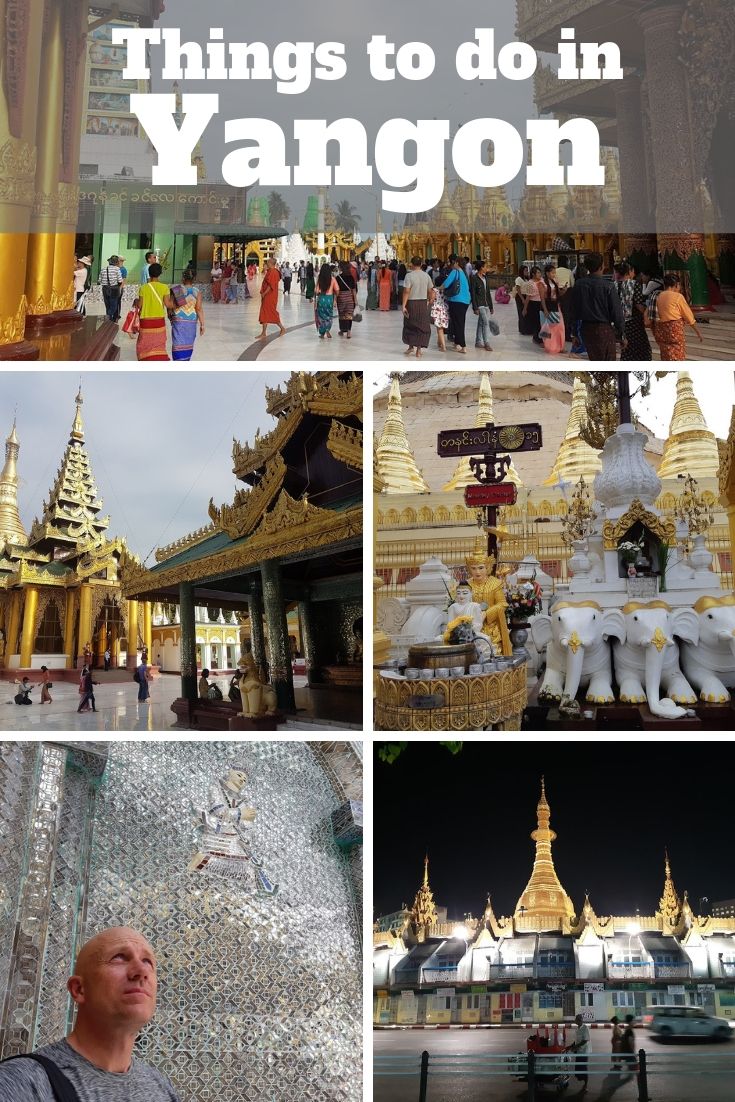
Things to Do in Yangon – Our thoughts
Yangon was an interesting city to spend a few days at and appreciate the local culture in Myanmar’s capital. It has enough to keep you occupied for several days, especially if you want to do a day trip or two.
Have you been to Yangon Myanmar? What did you think? Let us know in the comments!